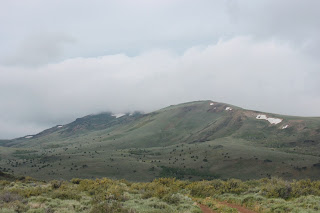Sad but true, it was time to say good-bye to Hart Mountain Antelope Refuge. Our visit was just temporary, I think only the antelope get to stay there on a year round basis. Merle, John, and I piled into the car and headed towards the Summer Lake area in south-central Oregon.
 |
Don't drink the water at Abert Lake
|
After a breakfast in Lakeport of real food that was not reconstituted over my Jet-Boiler, we headed north and stopped at Abert Lake. In this area of Oregon, seismic processes have uplifted huge blocks of land; Hart Mountain is a prime example of one of these upliftings. Eons ago, huge Lake Chewaucan covered this area but over time the waters receded. Because the lake basin had and has no outlet, minerals and salts have accumulated, leaving behind a series of alkali lakes. Abert Lake is one of these.
 |
| Abert Lake panorama |
Abert Lake is flanked by a tall 1,500 foot high escarpment, typical of this area. The waters are alkali so the lake is undeveloped and the remoteness assures little visitors to the toxic lake. Life does thrive in the waters, however, in the form of brine shrimp which have adopted to the strange brew in Abert Lake. Because of the shrimp, the lake is a haven for birds who feed on the shrimp while drinking water from the freshwater tributary creeks. You can eat the shrimp but don't drink the water.
 |
| A sign we are not in Roseburg any more |
Apparently bighorn sheep hang out on the escarpment face but even though we stared hard at the cliff, we did not see any. There was a highway sign warning of bighorn sheep crossing, so much for being "ram tough".
 |
| Summer Lake |
We continued on to Abert Lake's relative, Summer Lake. Summer Lake also has its origins in Lake Chewaucan's demise, making lakes Abert and Summer kissing cousins of sorts. Summer Lake, because of the prevailing winds, has accumulated a large tract of sand dunes on east side.
 |
| Summer Lake panorama |
After snapping some pictures of Summer Lake, we continued on up the west side escarpment known as Winter Ridge. Winter Ridge was named by John Fremont as it was snowy when he explored the area. Working his way down the escarpment (without the benefit of a gravel road), his party arrived at the alkali lake. "Ooh, first it's cold, then it's hot" he said. Actually that sounds like something I would say, but the end result is that the lake was named Summer Lake.
 |
| Our home for the next three nights |
Rock Creek Campground, on top of Winter Ridge's broad plateau, would be our home for the next three nights. The road into the campground was extremely rough and I uttered a "Forgive me Dollie, for I am about to sin" each time I drove her car on the rocky track.
 |
| Our nightly ritual |
The forest here has been decimated by beetles and the dead trees had been cut down, making for an abundant supply of readily available firewood. Since the nightly temperatures dipped into the 20's during our stay, we enjoyed some rather robust campfires.
 |
| Pretty but way cold |
So, that's it for this brief travelogue, you can
visit the Flickr album for more pictures of our relocation from Hart Mountain to Winter Ridge.























































